Portal:Mesoamerica/Selected article/8

Human sacrifice was a religious practice characteristic of pre-Columbian Aztec civilization; the extent of the practice is debated by modern scholars. Spanish explorers, soldiers and clergy who had contact with the Aztecs between 1517, when an expedition from Cuba first explored the Yucatan, and 1521, when Hernan Cortes conquered the Aztec capital of Tenochtitlan, made observations of and wrote reports about the practice of human sacrifice. For example, Bernal Díaz's The Conquest of New Spain includes eyewitness accounts of human sacrifices as well as descriptions of the remains of sacrificial victims. In addition, there are a number of second-hand accounts of human sacrifices written by Spanish friars that relate the testimony of native eyewitnesses. The literary accounts have been supported by archeological research. Since the late 1970s, excavations of the offerings in the Great Pyramid of Tenochtitlan, Teotihuacán's Pyramid of the Moon, and other archaeological sites, have provided physical evidence of human sacrifice among the Mesoamerican peoples.
Human sacrifice among pre-Columbian indigenous populations is a controversial topic. The discussion of human sacrifice is connected with the classic conflict between viewing indigenous peoples as either "noble savages" or "primitive barbarians." Within modern scholarship, some scholars tend to romanticize the description of human sacrifice while others tend to exaggerate it.
